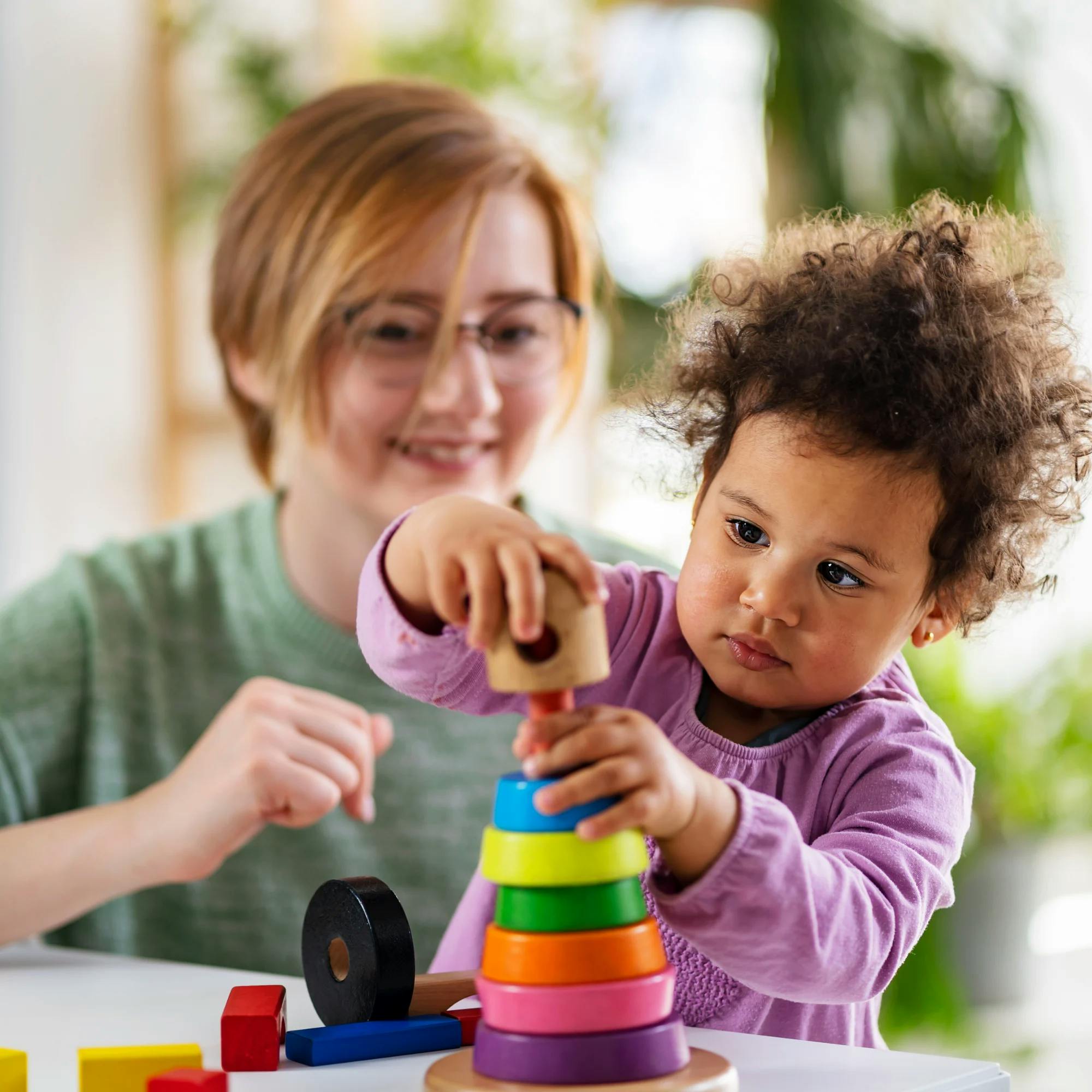If your child is newly diagnosed with autism, it’s normal to feel a range of emotions. You may be overwhelmed thinking about all the new things you need to learn and navigate. You’re likely also wondering how to best support your child, both at home and at school. Will your child need services such as therapy? If so, what kind, and how do you get started?
Taking in all this new information, with all these emotions and questions–it’s a lot to cope with. Whatever you’re feeling right now, it’s valid. Let’s take it one step at a time and explore what to do after learning your child is autistic.


Common emotions after a diagnosis
Hearing that your child is autistic can cause a variety of emotions. Many caregivers of children with special needs describe feeling grief. You might mourn what you thought your relationship with your child would look like and what their future would hold.
You may feel stressed knowing you have a lot to learn. It can be overwhelming to think about looking for therapists or other professionals to help your child.
There may also be a sense of relief or optimism. You may have wondered if your child was autistic, and you feel relieved to have an answer. You may recognize that having an official diagnosis helps kids get access to services they need, such as speech therapy.
Everyone has different emotions, and their feelings may change or fluctuate over time. There is no one right or wrong way to feel.


Understanding autism as a difference, not a disorder
It’s important to understand what autism is. Autism is a naturally occurring difference in processing, learning, and communicating. Sometimes called autism spectrum disorder (ASD), it refers to a broad range of developmental conditions and behaviors. Autistic people often have differences and challenges in speech and nonverbal communication, social interactions, and relationships with other people.
Autism, like ADHD, dyslexia, and dyspraxia, is a form of neurodivergence. Neurodivergence refers to people whose brains work differently than what society considers “normal.” Neurodivergent people may have differences in communication, learning, social preferences, and behavior.
Neurodivergence is not positive or negative, desirable or undesirable. It’s simply another way of relating to the world. There is nothing “wrong” with the brains of autistic people. There are many strengths that can come along with autism, such as:
Focus and attention to detail
Strong long-term memory
Creative problem-solving abilities
Enhanced visual and auditory skills


The first steps to take after an autism diagnosis
After big news like this, it helps to plan out some next steps for your child and your family. These steps may look somewhat different for each family, but here are some general recommendations to consider.
1 Connect with a speech therapist
One thing you’ll want to do soon is contact a speech therapist, if you haven’t already. Speech therapy can help autistic children become better communicators. You’ll also learn how best to communicate with your child. And better communication leads to less frustration–good news for everybody!
You can start looking for a speech therapist by talking to your child’s pediatrician or searching online. Your health insurance may also have a list of covered speech therapy providers. When choosing a speech therapist, look for someone who:
Acknowledges developmental differences
Focuses on relationship-building and strategies for regulation and connection
Uses a child-led approach
Honors all forms of communication–not just verbal speech
We explain more about how speech therapy for autism works later in this article.


2 Talk with your child’s teachers
If your child is in school, it’s important to tell their teacher about their autism diagnosis. Your child can receive support services at school, such as an Individualized Education Program (IEP).
An IEP is a legal document in the United States that is developed for each child with special needs. The IEP is created by a team of teachers, specialists, therapists, and parents/guardians. It documents the child’s academic needs and goals and how they will be met in public school. An IEP might include special education services and classroom accommodations. Accommodations are changes to the child’s learning environment that help them succeed in school.


3 Learn more about autism
As you feel ready, another step to take is to learn more about autism. You can talk with doctors, therapists, and parents of autistic children to learn more about what to expect. Finding out what services your child may need is a huge part of this. The right support early on will help your child reach goals they may not be meeting on their own.
It’s also important to hear and learn directly from autistic people. When you know what your child is experiencing, or what they’re likely to go through, you can understand and empathize with them and be better prepared.
Some of our favorite resources include these neurodivergent and/or neurodiversity-affirming speech therapists: Andi Putt, Rachel Dorsey, Cari Ebert (also the parent of an autistic child), and Play Spark.
Here are just a few links to learn more from autistic people:
Unmasking Autism by Devon Price
Neuroqueer Heresies: Notes on the Neurodiversity Paradigm, Autistic Empowerment, and Postnormal Possibilities by Nick Walker
Social media content that uses the hashtag #ActuallyAutistic
By learning all you can, you’ll also feel more confident talking about and advocating for your child’s needs with teachers and other adults in your child’s life. Having a team of support for your child is key.
4 Find any support you need
Many parents of autistic kids benefit from a support group, whether it’s online or in person. Support group members can understand each other’s experiences. They can also share valuable suggestions for therapies, specialists, and other resources. While some members’ children may be newly diagnosed, others may have been living with neurodivergence for some time. Hearing these different perspectives can be helpful.
To find a support group, ask your child’s doctor or therapist for recommendations, or search on a social media platform like Facebook. The American Speech-Language-Hearing Association offers resources as well.


What to expect in speech therapy for autism
Speech therapy will support your child’s communication development, whether they use speech to communicate, are non-speaking, use AAC, or are anywhere in between!
Your speech therapist will create a treatment plan with goals specific to your child’s individual needs. The goals might focus on using other forms of communication beyond speech, such as gestures or AAC. Or, your child’s goals may include increasing their expressive vocabulary or using longer sentences. The goals should be as functional as possible so they can benefit your child in their everyday life, not just in therapy sessions.
If you have specific goals you’d like your child to work on, be sure to tell your speech therapist. It’s likely they’ll be able to incorporate these requests into therapy. Kids make the most progress when their family and therapist collaborate together!
Studies have shown that when caregivers work on speech and language at home with their autistic child, even more progress is made. Your speech therapist can offer lots of guidance for how to do this. The more you practice with your child, the faster their communication skills will grow.
Personalized care for your child
We support autistic children for who they are and help them build new skills. Get matched with a licensed speech therapist today.
 Get started
Get startedLooking for a speech therapist experienced with autism?
We hope this information is helpful as you navigate this new time in your family’s life. Click here to get matched with an Expressable speech therapist who's experienced with autism. We’d be happy to answer your questions and share how we support autistic kids and their families.
An important note: We believe that when speaking about any community as a whole, the best approach is to prioritize that community’s voices, needs, and preferences. Within the larger autism community, the current language preference is identity-first (e.g., "autistic adults"), which is why we use that language in our content. Expressable is committed to listening to and learning from the populations we serve. If and when their preferences change, we’ll adjust our approach accordingly.
How Expressable Can Help
Concerned your child isn't reaching age-expected milestones? Looking for communication support from a professional? Expressable is a national online speech therapy practice serving children and adults. We treat all major areas of communication and feeding, offer flexible hours including evenings and weekends, and accept most major health insurance plans. We’re proud to have earned more than 3,000 5-star reviews from our clients (4.9/5 average).
Our therapy model is centered on parent and caregiver involvement. Research proves that empowering caregivers to participate in their loved one’s therapy leads to better outcomes. That’s why we combine live, 1-on-1 speech therapy with personalized education and home practice activities for faster progress.
Communication is more than words. It’s how we share how we feel and show who we are. We’re here to help you or your child do just that.
 Abby Barnes, M.S., CCC-SLP
Abby Barnes, M.S., CCC-SLP








